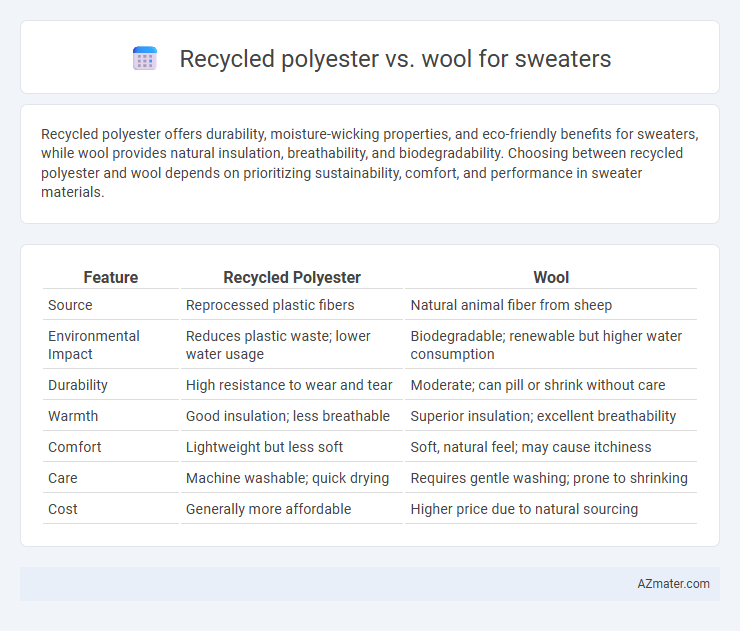Recycled polyester offers durability, moisture-wicking properties, and eco-friendly benefits for sweaters, while wool provides natural insulation, breathability, and biodegradability. Choosing between recycled polyester and wool depends on prioritizing sustainability, comfort, and performance in sweater materials.
Table of Comparison
| Feature | Recycled Polyester | Wool |
|---|---|---|
| Source | Reprocessed plastic fibers | Natural animal fiber from sheep |
| Environmental Impact | Reduces plastic waste; lower water usage | Biodegradable; renewable but higher water consumption |
| Durability | High resistance to wear and tear | Moderate; can pill or shrink without care |
| Warmth | Good insulation; less breathable | Superior insulation; excellent breathability |
| Comfort | Lightweight but less soft | Soft, natural feel; may cause itchiness |
| Care | Machine washable; quick drying | Requires gentle washing; prone to shrinking |
| Cost | Generally more affordable | Higher price due to natural sourcing |
Introduction to Sweater Materials: Recycled Polyester vs Wool
Recycled polyester and wool represent two distinct materials widely used in sweater production, each offering unique benefits in sustainability and performance. Recycled polyester is derived from post-consumer plastic waste, reducing environmental impact by diverting materials from landfills and lowering carbon emissions compared to virgin polyester. Wool, a natural fiber sourced from sheep, is biodegradable, renewable, and known for exceptional insulation, moisture-wicking, and durability in cold weather garments.
Production Process: How Recycled Polyester and Wool Are Made
Recycled polyester is produced by melting down post-consumer plastic bottles or industrial polyester waste and re-spinning them into new fibers, significantly reducing reliance on virgin petroleum resources and lowering carbon emissions. Wool is sourced from sheep through shearing, followed by cleaning, carding, spinning, and sometimes dyeing, a process that involves natural fiber regeneration but has higher land, water, and methane emission footprints. The energy consumption for recycled polyester manufacturing is generally lower than wool production, making it a more sustainable option in terms of resource use and environmental impact.
Environmental Impact: Comparing Sustainability Factors
Recycled polyester reduces landfill waste and requires less water than wool production, making it a lower-impact material in terms of resource use. Wool, while biodegradable and renewable, involves methane emissions from sheep and land use concerns that contribute to its environmental footprint. Choosing between recycled polyester and wool depends on prioritizing waste reduction or natural biodegradability in sustainable sweater production.
Comfort and Feel: Texture Differences Between Fabrics
Recycled polyester sweaters offer a smooth, lightweight texture that feels soft against the skin and provides excellent moisture-wicking properties, making them ideal for active wear. Wool sweaters deliver a natural warmth with a slightly coarse texture that can vary from soft merino wool to more rugged fibers, offering breathability and insulation. While wool provides a cozy, tactile richness perfect for cold climates, recycled polyester excels in durability and easy care with a consistently smooth feel.
Breathability and Warmth: Which Material Performs Better?
Wool outperforms recycled polyester in both breathability and warmth due to its natural fiber structure, which efficiently traps heat while allowing moisture to escape, keeping the wearer dry and comfortable. Recycled polyester tends to retain moisture and can feel less breathable, leading to reduced thermal regulation during physical activity or varying temperatures. For optimal warmth and ventilation in sweaters, wool remains the superior choice, especially in colder, damp conditions.
Durability and Longevity of Sweaters
Recycled polyester offers superior durability and resistance to wear, making it less prone to shrinking and stretching compared to wool sweaters. Wool provides excellent natural insulation and breathability but is more susceptible to pilling, moth damage, and requires careful maintenance to preserve longevity. For long-term use, recycled polyester sweaters tend to maintain their shape and color better, while wool sweaters benefit from natural resilience if properly cared for.
Care and Maintenance: Cleaning and Storage Tips
Recycled polyester sweaters require machine washing on a gentle cycle with cold water and mild detergent, drying flat to maintain shape and prevent damage, while wool sweaters benefit from hand washing or dry cleaning to avoid shrinkage and fiber distortion, and should be dried flat away from direct heat sources. When storing, recycled polyester resists moth damage, allowing for flexible storage in sealed containers or drawers, whereas wool sweaters need breathable storage solutions with cedar blocks or mothballs to protect against pests and maintain fiber integrity. Proper care extends the lifespan of both fabrics, with recycled polyester being more durable under frequent washing and wool needing more delicate handling to preserve softness and insulation.
Cost Comparison: Affordability and Value
Recycled polyester sweaters generally offer greater affordability compared to wool, with prices often 30-50% lower due to lower raw material and production costs. Wool sweaters provide superior insulation and durability, delivering long-term value despite higher upfront expenses, typically ranging from $80 to $200 versus $40 to $100 for recycled polyester. Consumers seeking budget-friendly options benefit from recycled polyester's cost-effectiveness, while those prioritizing warmth and longevity may consider wool as a worthwhile investment.
Style and Appearance: Design Flexibility
Recycled polyester offers high design flexibility with vibrant color retention and the ability to mimic various textures, making it ideal for trendy, modern sweater styles. Wool provides a classic, natural appearance with inherent texture and depth, lending itself to timeless and sophisticated sweater designs. Both materials accommodate different aesthetic preferences, but recycled polyester excels in customizable patterns and finishes while wool emphasizes traditional elegance.
Conclusion: Choosing the Right Material for Your Sweater
Recycled polyester excels in durability, moisture-wicking, and sustainability with lower water usage and carbon footprint compared to traditional fabrics. Wool offers superior warmth, breathability, and natural insulation, ideal for cold climates and those seeking natural fibers. Selecting the right sweater material depends on prioritizing eco-friendliness and easy care (recycled polyester) or natural warmth and comfort (wool).

Infographic: Recycled polyester vs Wool for Sweater
 azmater.com
azmater.com